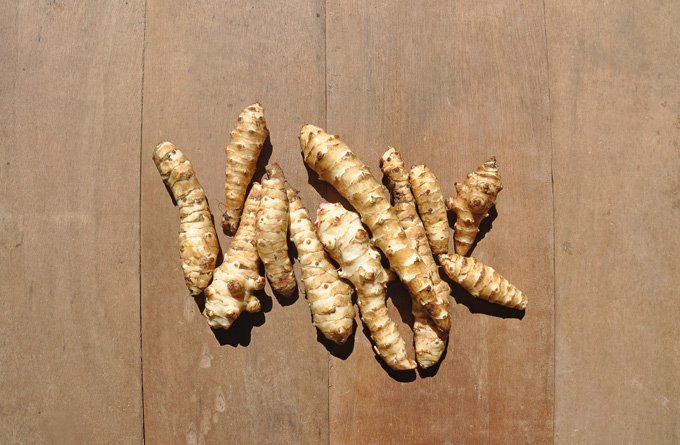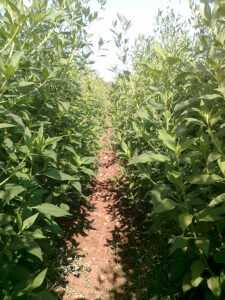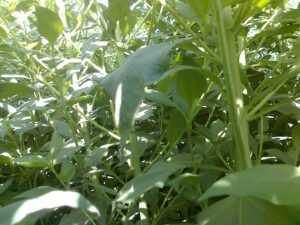Though autumn is officially here, our field is having separation anxiety over parting from the summer crops. The last corncobs are just about to be harvested (scheduled to arrive at your dinner tables next week), and the other summer children are still ripening in our field: peppers, eggplants, lubia and okra are being harvested and delivered to your homes, as we write. It is high time to prepare your last autumn caponatas, so if you are – like yours truly – a procrastinator, you have earned one last chance…..
At the same time, the winter crops have begun crowding your boxes: fresh salad greens and yummy cooking greens, beets, turnips and radishes – Welcome, guys! Amidst this whole colorful assortment of summer-and-winter-mixed-into-autumn, we have one very distinctive autumn vegetable, growing now, being very punctual and improving every dish…Can you guess who this is?
Yes! Introducing the incredible sunroot, aka Helianthus tuberosus, or better yet by its very confusing moniker: the Jerusalem Artichoke. But first, a clarification: the sunroot does look like ginger, but it certainly is not ginger!
We waited for them over six months, till the bushes dried up and wilted. Only then could we chop those down and begin pulling out the secret treasures buried below – delectable, satiating bulbs that will enhance every soup, quiche, antipasti or salad. And you don’t need a lot — they can be used just for seasoning. Here in Chubeza, sunroots are one of our younger products. After an experimental crop several years ago, we were pleased with the outcome. Actually, more than pleased. And ever since then, they have been steady autumn tenants.
This great photo from Gal’s blog, Ptitim:

In America, they’re commonly known as “sunchokes,” but actually the title “sunroot” is an accurate description, for the Jerusalem artichoke is in fact a species of sunflower which develops an edible root bulb. The origins of this delectable bulb are in the North American East Coast from Georgia to Nova Scotia, where it has been both growing wild and cultivated in Native American vegetable gardens for years on end. The bulb fully enjoys the American sunshine and rich, fertile earth, yielding farmers and gleaners its rich roots that abound with energy and sweetness.
The Europeans, who came to visit and stayed to conquer, tasted the sunroot and loved it. The first to describe the bulb was French explorer Samuel de Champlain, who noticed it in a Cape Cod vegetable garden in 1602. He sent some sunroots to France, from where they meandered to England, Germany and Italy in the 17th century. The Italians termed it girasole, Italian for “sunflower.” Somehow the pronunciation was distorted to “Jerusalem,” and it stuck. The “artichoke” part came from the fact that it somewhat resembles the artichoke in taste.
Like any sunflower, the sunroot adores the sun and thrives during the summer. For Chubeza, this is the sixth summer we’ve watched its growth. I say “watch,” because from the moment we placed the bulbs in the earth until we plunged the pitchfork in to remove them, we really did not have much to do (aside from occasional weeding and watering). We were rather amazed at the beautiful strength of its growth, at its ability to joyfully grow wild and dare the weeds to even think of coming close. In our field, the Jerusalem artichoke is free from pests (moles and rats are their natural nemesis), which is why we could just step aside and simply watch it grow. Patiently.
Here it is going wild, blooming, growing. The Jerusalem artichoke in Chubeza:



And yes, it required much patience. The plant took its sweet time for at least seven months, growing, wilting and clandestinely swelling up its unique roots. In October when the foliage had dried up, we inserted the pitchfork to examine the situation, only to discover that we needed more patience. So we waited a bit longer, regularly sampling some to gobble up for lunch. Now, a month later, we are finally beginning to pull out all these yummy, distinctive bulbs. Welcome, gals!
Though it grows underground like the potato (even if it is more stubborn and recalcitrant than the latter) and has a similar caloric value, the Jerusalem artichoke is low in carbs. Instead of starch, it contains inulin, a fruit sucrose carbohydrate, soluble in water (which is how it stores its energy in the root bulb). Inulin aids in lowering blood sugar levels, making it recommended for diabetics (contrary to potatoes!). Inulin feeds the friendly microbes in the intestines and reduces the threat of a variety of diseases. On the other hand, it may cause gas, so if you’re first beginning to eat Jerusalem artichokes, start slowly to get the body accustomed. These bulbs are an excellent source of thiamine, iron, niacin, Vitamin B3 and potassium. Chinese medicine classifies the Jerusalem artichoke as a warming vegetable which strengthens the digestive system. A great winter vegetable!
And again, contrary to potatoes, they must be refrigerated, preferably in a closed plastic bag or sealed plastic container, to prevent them from growing soft. If you wish, you may peel it. If you don’t like peeling the knobby bulbs, here are some tips from Phyllis Glazer:
The Jerusalem artichoke turns black quickly after being peeled, so it is recommended to place it in a bowl filled with water and two tablespoons of lemon juice, or simply drop into milk and cook away. Soaking in water causes the vegetable to lose the B vitamins, which are soluble. Thus it’s best to peel them and give the artichokes a quick soak, or soak from time to time in a water and lemon juice solution while peeling. You can also scrub them well and cook them unpeeled (a young Jerusalem artichoke can be eaten with peeling) and then use the soaking water for soup or other type of dish. If the bumps make it hard to peel, steam the roots for several minutes to remove the peeling with ease.
Check our recipe section for a variety of suggestions for cooking and serving the amazing sunroot, but feel free to add it to other familiar and favorite recipes in your own creative way. It really enhances the flavor in nearly every dish. Bon appetite!
Wishing us all a good and healthy week,
Alon, Bat Ami, Dror, Yochai and the entire Chubeza team
________________________________
WHAT’S IN THIS WEEK’S BOXES?
Monday: Coriander/dill, bell peppers/eggplant, lettuce, cucumbers, red mizuna/arugula , tomatoes, Swiss chard/kale/ New Zealand spinach, baby radishes/daikon, sweet potatoes, red potatoes/pumpkin, leeks/onions.
Large box, in addition: Beets, corn, Jerusalem artichoke/yard-long beans/okra
Wednesday: Coriander/dill, bell peppers/eggplant, lettuce/New Zealand spinach, cucumbers, red mizuna/arugula/tatsoi, tomatoes, Swiss chard/kale/winter spinach, radishes/daikon, sweet potatoes, onions, Jerusalem artichoke/yard-long beans.
Large box, in addition: Beets/turnips/pumpkin, corn, leeks.
And there’s more! You can add to your basket a wide, delectable range of additional products from fine small producers: flour, sprouts, honey, dates, almonds, garbanzo beans, crackers, probiotic foods, dried fruits and leathers, olive oil, bakery products, granola, natural juices, cider and jams, apple vinegar, dates silan and healthy snacks, ground coffee, tachini, honey candy and goat dairy too! You can learn more about each producer on the Chubeza website. On our order system there’s a detailed listing of the products and their cost, you can make an order online now!
